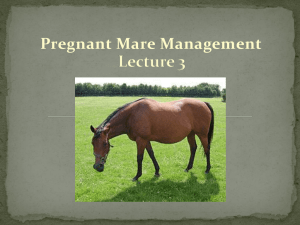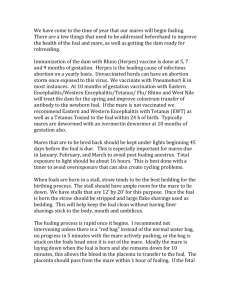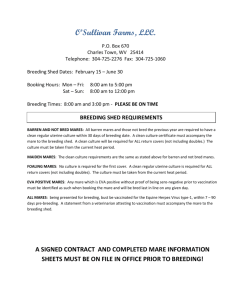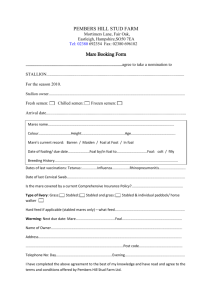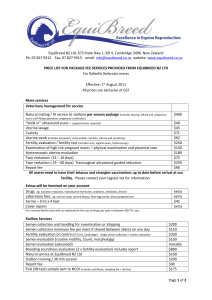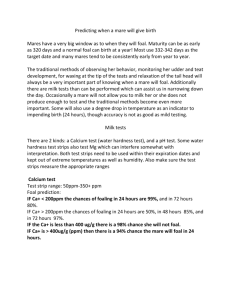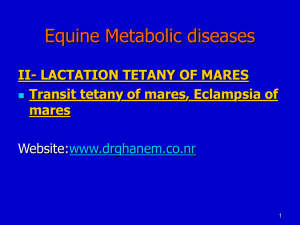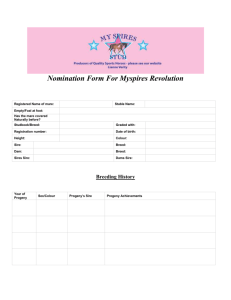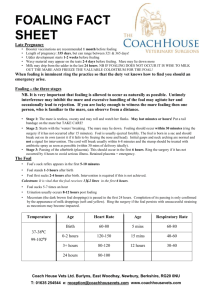Preparing for the Equine Breeding Season
advertisement
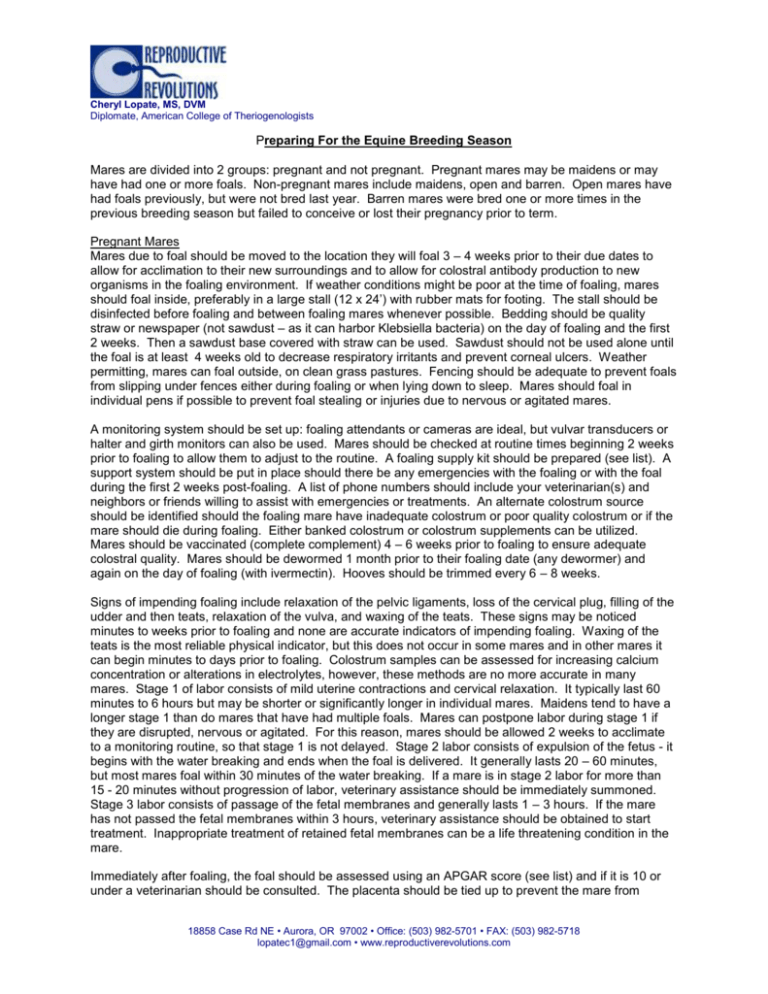
Cheryl Lopate, MS, DVM Diplomate, American College of Theriogenologists Preparing For the Equine Breeding Season Mares are divided into 2 groups: pregnant and not pregnant. Pregnant mares may be maidens or may have had one or more foals. Non-pregnant mares include maidens, open and barren. Open mares have had foals previously, but were not bred last year. Barren mares were bred one or more times in the previous breeding season but failed to conceive or lost their pregnancy prior to term. Pregnant Mares Mares due to foal should be moved to the location they will foal 3 – 4 weeks prior to their due dates to allow for acclimation to their new surroundings and to allow for colostral antibody production to new organisms in the foaling environment. If weather conditions might be poor at the time of foaling, mares should foal inside, preferably in a large stall (12 x 24’) with rubber mats for footing. The stall should be disinfected before foaling and between foaling mares whenever possible. Bedding should be quality straw or newspaper (not sawdust – as it can harbor Klebsiella bacteria) on the day of foaling and the first 2 weeks. Then a sawdust base covered with straw can be used. Sawdust should not be used alone until the foal is at least 4 weeks old to decrease respiratory irritants and prevent corneal ulcers. Weather permitting, mares can foal outside, on clean grass pastures. Fencing should be adequate to prevent foals from slipping under fences either during foaling or when lying down to sleep. Mares should foal in individual pens if possible to prevent foal stealing or injuries due to nervous or agitated mares. A monitoring system should be set up: foaling attendants or cameras are ideal, but vulvar transducers or halter and girth monitors can also be used. Mares should be checked at routine times beginning 2 weeks prior to foaling to allow them to adjust to the routine. A foaling supply kit should be prepared (see list). A support system should be put in place should there be any emergencies with the foaling or with the foal during the first 2 weeks post-foaling. A list of phone numbers should include your veterinarian(s) and neighbors or friends willing to assist with emergencies or treatments. An alternate colostrum source should be identified should the foaling mare have inadequate colostrum or poor quality colostrum or if the mare should die during foaling. Either banked colostrum or colostrum supplements can be utilized. Mares should be vaccinated (complete complement) 4 – 6 weeks prior to foaling to ensure adequate colostral quality. Mares should be dewormed 1 month prior to their foaling date (any dewormer) and again on the day of foaling (with ivermectin). Hooves should be trimmed every 6 – 8 weeks. Signs of impending foaling include relaxation of the pelvic ligaments, loss of the cervical plug, filling of the udder and then teats, relaxation of the vulva, and waxing of the teats. These signs may be noticed minutes to weeks prior to foaling and none are accurate indicators of impending foaling. Waxing of the teats is the most reliable physical indicator, but this does not occur in some mares and in other mares it can begin minutes to days prior to foaling. Colostrum samples can be assessed for increasing calcium concentration or alterations in electrolytes, however, these methods are no more accurate in many mares. Stage 1 of labor consists of mild uterine contractions and cervical relaxation. It typically last 60 minutes to 6 hours but may be shorter or significantly longer in individual mares. Maidens tend to have a longer stage 1 than do mares that have had multiple foals. Mares can postpone labor during stage 1 if they are disrupted, nervous or agitated. For this reason, mares should be allowed 2 weeks to acclimate to a monitoring routine, so that stage 1 is not delayed. Stage 2 labor consists of expulsion of the fetus - it begins with the water breaking and ends when the foal is delivered. It generally lasts 20 – 60 minutes, but most mares foal within 30 minutes of the water breaking. If a mare is in stage 2 labor for more than 15 - 20 minutes without progression of labor, veterinary assistance should be immediately summoned. Stage 3 labor consists of passage of the fetal membranes and generally lasts 1 – 3 hours. If the mare has not passed the fetal membranes within 3 hours, veterinary assistance should be obtained to start treatment. Inappropriate treatment of retained fetal membranes can be a life threatening condition in the mare. Immediately after foaling, the foal should be assessed using an APGAR score (see list) and if it is 10 or under a veterinarian should be consulted. The placenta should be tied up to prevent the mare from 18858 Case Rd NE • Aurora, OR 97002 • Office: (503) 982-5701 • FAX: (503) 982-5718 lopatec1@gmail.com • www.reproductiverevolutions.com Cheryl Lopate, MS, DVM Diplomate, American College of Theriogenologists stepping on it. The mare’s udder should be washed and quality of the colostrum assessed. The foal should be given an enema and the mare and foal should be left alone to bond. The foal should receive 6 – 12 ounces of colostrum hourly beginning at one hour of age (1 – 1.5 qts within 8 hours). The mare should be milked and the foal bottle fed if it not nursing successfully on its own. The foal should defecate within 1 – 4 hours of birth and urinate within 3 – 8 hours of birth. Any straining should be discussed with a veterinarian. Foals that are too weak to stand or have lax tendons should be assisted while nursing or be bottle fed. The fetal membranes should be saved in their entirety for the veterinarian to examine. If there are no problems with the mare or foal, they should both be examined 12 – 18 hours after birth. A complete physical examination should be performed on the foal including assessment of the bite, palate, eyes, thyroid, heart, lungs, ribs, abdomen, umbilicus, inguinal region, scrotum (colts), perineum (fillies), joints, tendons and conformation. The IgG concentration should be determined and if it is low, either oral or intravenous supplementation should be administered. Vitamin E and selenium should be administered along with tetanus (if the mare was unvaccinated). The mare should have the perineum evaluated for injury and the udder examined for infection or inflammation. The placenta should be examined for completeness and for any abnormalities indicating infection, inflammation or scarring. Rebreeding the Foaling Mare Mares to be rebred on their foal heat should be assessed for uterine involution between days 7 – 9 post foaling. The decision to bred on foal heat is based on the number of days post-foaling that ovulation will occur (at least 10), the involution of the uterus (horns less than 15 cm), the absence of uterine luminal fluid or other signs of inflammation in the uterus, the absence of injury or inflammation in the vagina or cervix, the exercise level of the mare (stall bound mares are poor candidates), maternal anxiety (especially if being bred by natural service – separation from the foal for breeding may be too upsetting), and the lack of any history of dystocia or retained fetal membranes. Any deviation from normal of any of the above criteria will decrease the mare’s fertility and will increase the chances of early embryonic death. Mares foaling early in the breeding season should be maintained under 16 of light similar to open mares to prevent them from stopping cycling. Foal heat can be postponed by administering progesterone beginning on the second day post-foaling. Mares that are not bred on foal heat for any reason may be shortcycled on day 17 – 18 (if ovulation occurs prior to day 12 – 13) and then bred the following week, or be bred on the second cycle (~ day 30). Non-Pregnant Mares All non-pregnant mares should be palpated and ultrasounded at the onset of the breeding season. Any mare with evidence of fluid accumulation or inflammation should have an endometrial culture and cytology performed. Artificial lighting can induce cyclicity outside the natural breeding season. 16 hours of light is required for a minimum of 60 days for maximal effect. The closer to the start of the natural breeding season it is, the fewer the number of days of artificial light required to advance the onset of the first ovulation. A complete breeding soundness examination should be performed on any mare that was bred 2 or more times without conception, that are over 12 years old and have never foaled or foaled last more than 2 years previously, that have a history of pregnancy loss, abortion or early embryonic death, or that will be used for embryo transfer due to fertility problems. This examination includes rectal palpation, ultrasound examination, evaluation of the external genitalia, vaginal speculum and digital examination, endometrial culture, cytology and biopsy and in some cases hysteroscopy (viewing the uterine lumen with a camera). Based on the results of the BSE, any pre-breeding treatments can be determined and a breeding management plan can be formulated. Ovulation should be timed and induced in all mares. This will result in reduced inflammatory insult to the uterus, reduced stallion usage, reduced semen costs for collection, shipping and insemination, and reduced labor in the breeding shed. Ovulation timing requires veterinary examination using both rectal 18858 Case Rd NE • Aurora, OR 97002 • Office: (503) 982-5701 • FAX: (503) 982-5718 lopatec1@gmail.com • www.reproductiverevolutions.com Cheryl Lopate, MS, DVM Diplomate, American College of Theriogenologists palpation and ultrasound. Mares should be assessed for inflammation post-breeding (PMIE – post mating induced endometritis) and for poor uterine clearance and treated if either condition exists. These mares should be vaccinated routinely avoiding the period of the first 60 days of pregnancy whenever possible. They should be dewormed and have their feet trimmed every 6 – 8 weeks. Stallions Stallions should be collected to determine daily sperm output (DSO) prior to the onset of the breeding season. They can be brought to DSO by collecting once daily for 1 week, twice daily every other day for 3 days or every Monday, Wednesday and Friday for 2 weeks. Once the stallion is brought to DSO, the semen should be evaluated for motility, morphology, concentration, total spermatozoa per ejaculate, volume, pH, % intact acrosomes and longevity. They should be collected routinely 2 – 3 days per week irregardless of semen usage to keep dead cells flushed out of the reproductive tract. The semen extender to be used for the breeding season is determined based on results from cultures of the urethra and semen and from longevity trials. Any abnormalities in the semen evaluation should be noted and addressed. Booking numbers and contracts can be assigned based on this initial evaluation. Semen should be re-evaluated and cultures resubmitted every 4 – 6 weeks (if being bred with natural service) throughout the breeding season. If a change in fertility is noted based on pregnancy statistics semen quality should immediately be evaluated in detail. Stallions should be vaccinated, dewormed and have their feet trimmed on the same schedule as nonpregnant mares. Stallions should be cultured and have serology for EVA performed prior to the onset of their first breeding season. They should be vaccinated for EVA following the initial cultures at least 1 month prior to the breeding season, so that viral shedding is complete before any mares are bred. 18858 Case Rd NE • Aurora, OR 97002 • Office: (503) 982-5701 • FAX: (503) 982-5718 lopatec1@gmail.com • www.reproductiverevolutions.com
